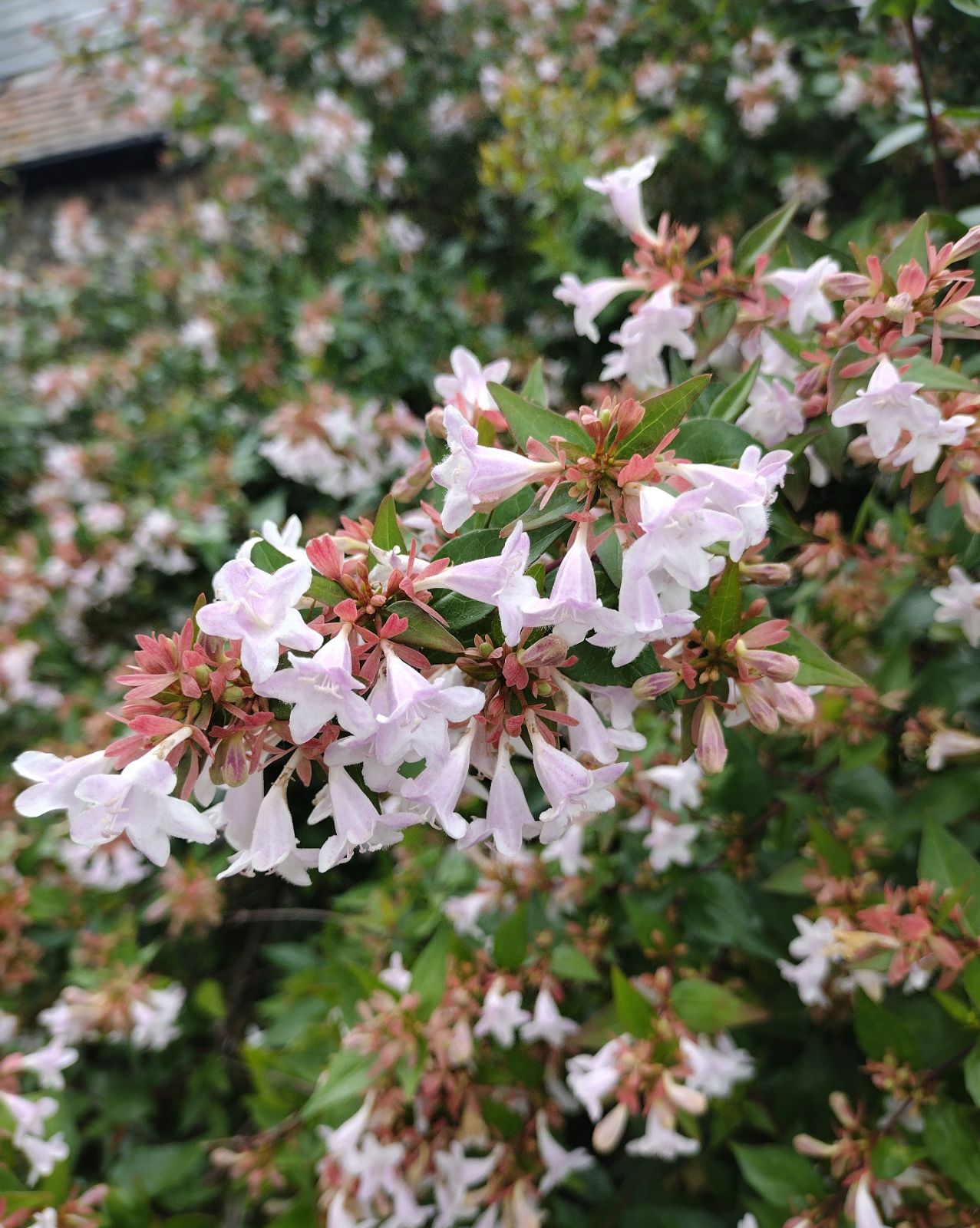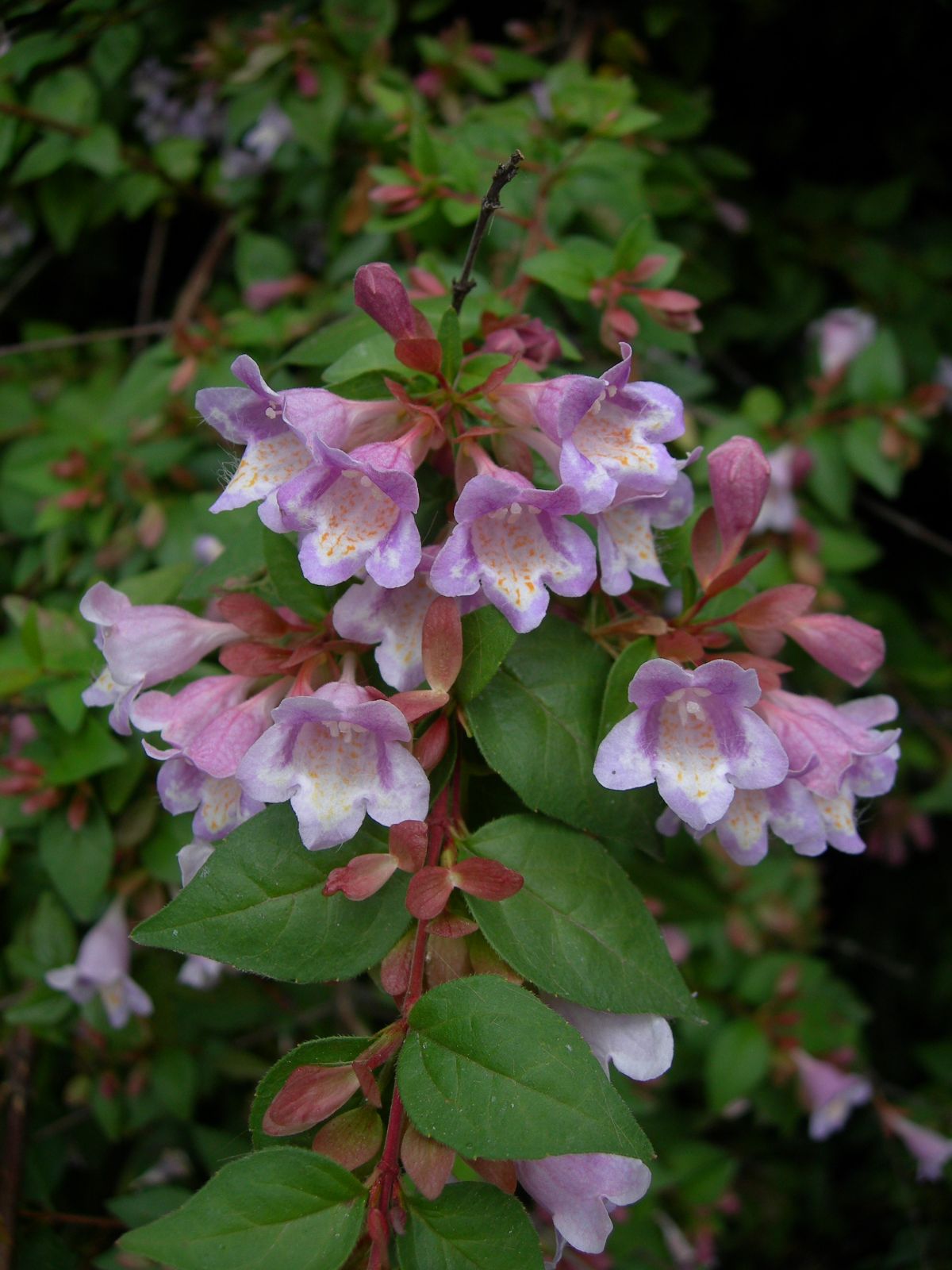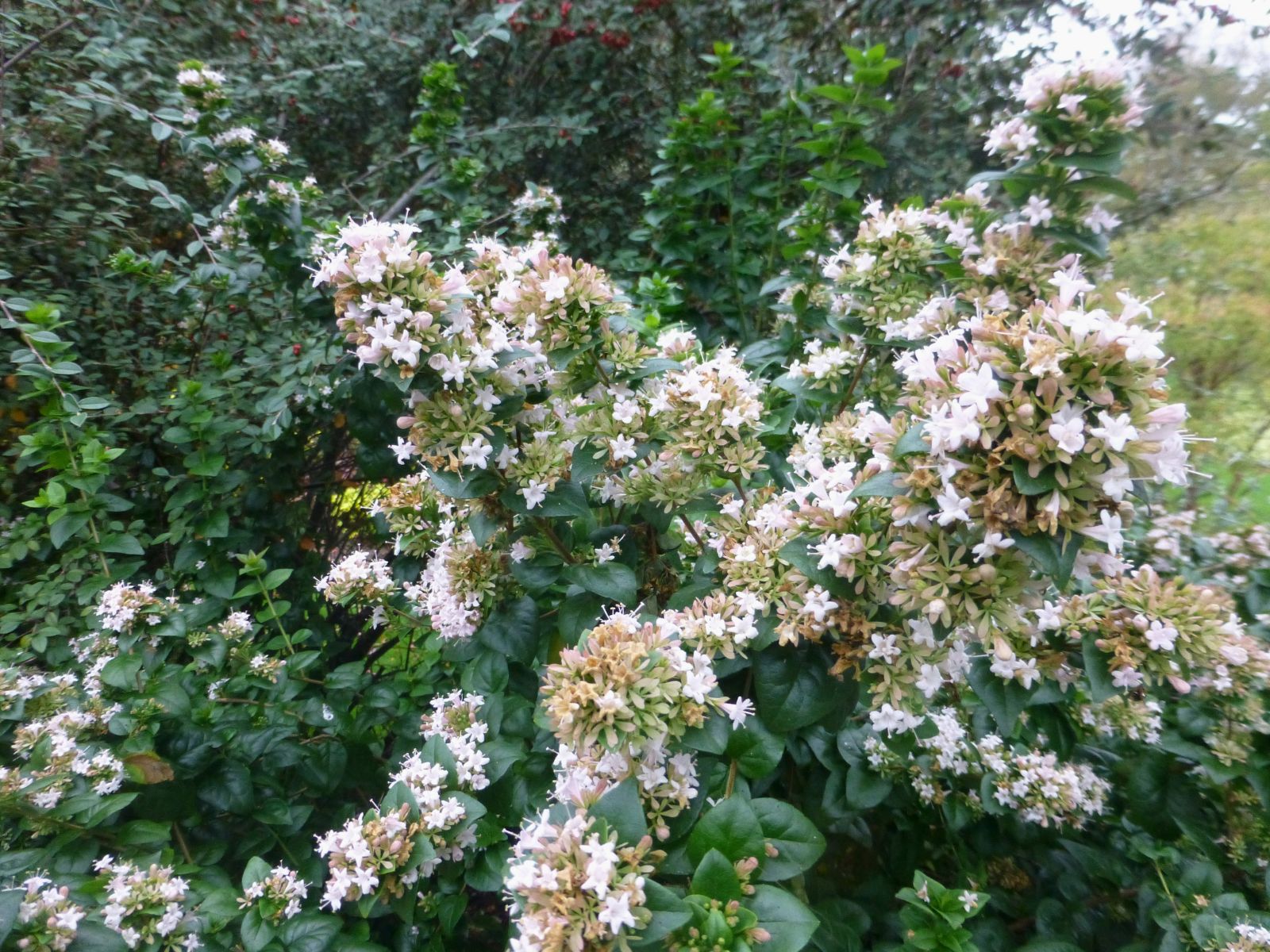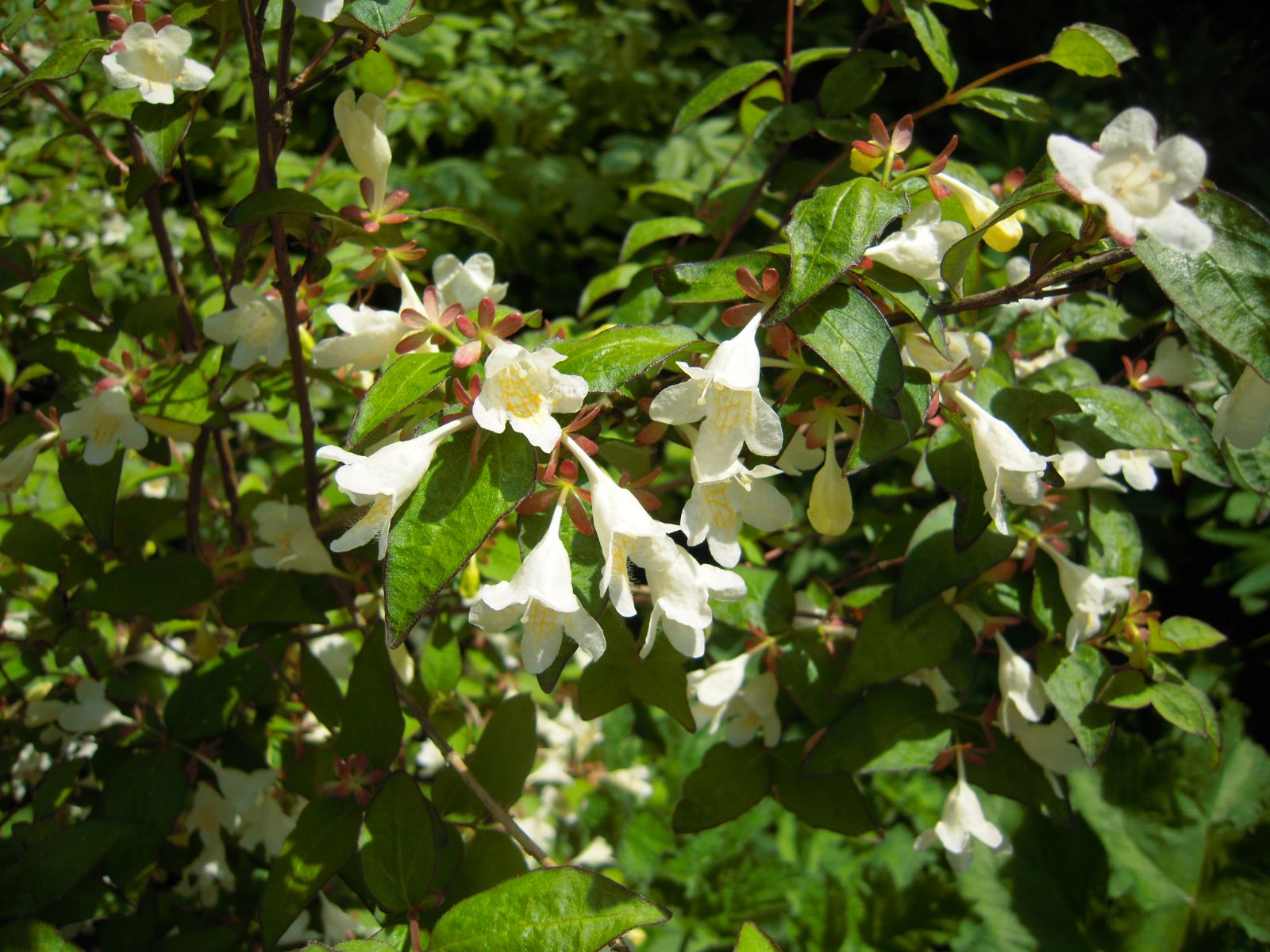Abelia
Sponsor
Kindly sponsored by
The Normanby Charitable Trust
Credits
Owen Johnson (2021)
Recommended citation
Johnson, O. (2021), 'Abelia' from the website Trees and Shrubs Online (treesandshrubsonline.
Family
- Caprifoliaceae
Common Names
- Abelia
5 species, endemic to China; shrubs to 2m, deciduous or semi-evergreen. Bark brownish-grey, developing irregular vertical fissures; buds opposite, with several pairs of scales. Leaves ovate to elliptic, 0.4–10 × 0.2–4 cm, entire or coarsely toothed, mostly glabrous and dotted with glands beneath; petiole short (1–4 mm). Flowers axillary or forming a terminal or subterminal dense thyrse, on long arching shoots. Flowers single or paired (if so then flowering consecutively), sometimes fragrant. Bracts (prophylls) 4 or 6. Calyx lobes 2–5, more or less equal, lanceolate to slightly spoon-shaped, 3–10 mm long, reddish, translucent, persistent. Corolla tubular to bell-shaped, 0.7–4 cm long, 5-lobed, white to purplish pink and sometimes marked orange in the throat. Stamens 4. Ovary thin, cylindrical, 3–10 mm long. Style 7–15 mm, exserted. Fruit a tubular achene 4–10 mm long, wind-dispersed, with the 5 sepals acting as wings. (Landrein & Farjon 2020).
When the 18th century Swedist botanist Karl von Linné (Linnaeus) formalised and popularised the concept of binomial names for every plant, which could be used all around the world and which should be ordered according to principles of family resemblance, he did not of course anticipate that such apparent resemblances would ever be confirmed, or in some cases confounded, by the study of DNA markers – or that the name-changes which might be felt necessary as a consequence would go a long way to undermining the intended universality of his system. In the great majority of cases, visual similarities are indeed proving to reflect the actual patterns by which plants can now be estimated to have evolved and speciated. One exception, unfortunately, is the hitherto familiar genus Abelia, which is likely to be the first name encountered in any alphabetically arranged flora, and which includes among its closest allies the Twin-flower (Linnaea borealis), the plant which Linnaeus had permitted be named in his honour.
As early as 1948 the Japanese botanist Tomitaro Makino had suspected that one group of plants which was then placed in Abelia (as Section Zabelia Rehder), and which included the small Himalayan tree ‘Abelia triflora’ and the sweetly-scented spring-flowering Korean shrub ‘Abelia tyaihyoni’ (better but quite wrongly known for many years as A. mosanensis), were not very closely related to the rest of the group and should be accorded their own generic name, Zabelia Makino; their distinct features include the abruptly widening base of the corolla of the flower and the swollen base of the leaf-stalk, which encloses next year’s bud. DNA analyses of plants across these groups – an enterprise launched in 1998 by an unpublished D. Phil. thesis by T. Kim from the Chonbuk National University in South Korea (Kim 1998) – have comprehensively endorsed Makino’s assumption, but also showed that the rump of ‘Abelia’ was still a rather disparate assortment, among which were nested three other entities which had long been understood as genera in their own right: Dipelta, Kolkwitzia (the Beauty Bush), and Linnaea itself (Landrein & Farjon 2020).
To accommodate this emerging picture, two ‘rival’ nomenclatural systems have been proposed, both by botanists based at the time at the Royal Botanic Gardens, Kew. Both recognise Zabelia as a distinct genus, but Maarten Christenhusz’s solution (Christenhusz 2013) has been to submerge Dipelta, Kolkwitzia and the remainder of Abelia within another, larger and more diverse genus, for which the earliest available published named is Linnaea. This scheme, first advanced in part by botanists such as Ludwig Diels in the early 20th century, has the advantage of simplicity and has recently been adopted by the authors of Wikipedia (Wikipedia 2021) – influencing much online discussion – and by Plants of the World Online (Plants of the World Online 2021), but a major disadvantage is that it requires new names for most of the plants in this group which happen to be most familiar to western gardeners, including Dipelta, Kolkwitzia and all of the commonly-grown near relatives of the first plants to be described under the name Abelia; for this reason Christenhusz’s nomenclature seems unlikely ever to gain favour among the wider horticultural community.
The alternative solution, proposed by Sven Landrein since 2012 (Landrein et al. 2012), has been to maintain the familiar genera Dipelta, Kolkwitzia and Linnaea, along with a reduced Abelia (to include the closest allies to A. chinensis as named by Robert Brown in 1818), and to adopt new – or to ressurect older – generic names for those plants which were traditionally considered to belong to Abelia but which turn out to be no more closely related to A. chinensis than are the members of Dipelta, Kolkwitzia and Linnaea themselves. The resulting ‘new’ genera are Diabelia Landrein (a largely Japanese group of shrubs with small paired flowers opening together) and Vesalea M. Martens and Galeotti (a distinct group from southern North America with slender red flowers, for which this generic name had originally been proposed as long ago as 1844), and the aforementioned Zabelia (Rehder) Makino. A major advantage of this scheme is that it minimises name changes among those species most familiar to gardeners. Accordingly, this nomenclature has been adopted (in large part) by the Royal Horticultural Society (Royal Horticultural Society 2021) and The Hillier Manual of Trees and Shrubs (Edwards & Marshall 2019), and is followed, in its entirety, in accounts for these genera on Trees and Shrubs Online.
Although the ‘Abelias’ of the greatest horticultural importance will all be found under Abelia below, users should refer to Diabelia, Vesalea and Zabelia for coverage of many rarer taxa which were included as part of Abelia by older references such as Trees and Shrubs Hardy in the British Isles (Bean 1976, etc), older editions of the Hillier Manual, or Dirr’s Manual of Woody Landscape Plants (Dirr 2009). Landrein’s interpretation of this group of taxa was endorsed in the publication in 2020 by the Royal Botanic Gardens, Kew, of A monograph of Caprifoliaceae: Linnaeeae, co-authored by Landrein and by Aljos Farjon: a 200-page text of impeccable scholarship but also of great beauty, with its high-definition scans of herbarium specimens and detailed distribution maps (Landrein & Farjon 2020).
As understood here, Abelia becomes a small and relatively uniform genus of shrubs which are more or less endemic to China. (The natural range of A. chinensis var. hanceana (M. Martens ex Hance) Landrein extends eastwards through Taiwan as far as the Japanese Ryukyu Islands, while that of A. macrotera var. deutziaefolia (H. Lév.) Landrein extends just southwards into the mountains of North Vietnam (Landrein & Farjon 2020). The narrowly bell-shaped flowers, white to purplish-pink and sometimes prettily marked with orange or yellow in the throat, are often sweetly scented, attracting butterflies in particular, and are backed with slender, translucent, reddish or purplish sepals; the contrast of white or pink and red with the small deep-green and often shiny leaves also tends to be very satisfying. Flowering begins in summer and can continue quite showily in some selections until Christmas; these forms are semi-evergreen but the leaves will bronze or turn reddish in response to winter cold. No Abelia is hardy much beyond USDA zone 6, and all need plenty of warmth during summer to flower well; in the cool conditions of north-western Europe they tend to perform best under a south-facing wall.
Most species are diploid and probably self-incompatible (Landrein & Farjon 2020). They do not layer or sucker and production of the wind-dispersed seedheads is also sparse; the garden forms are bred by cuttings from half-ripe wood, which should be taken in July and placed in pots of sandy soil with a little bottom heat (Bean 1976). One potential advantage to gardeners is that the genus’ foliage is unpalatable to deer and rabbits (Dirr 2009), and Abelias in general suffer from very few diseases. Plants can be pruned in spring every two or three years to maintain form and vigour (Stewart 2021), though many modern clones have been selected for their naturally tidy growth-form.
The distribution of the five species accepted by Landrein and Farjon (Landrein & Farjon 2020) tends to form an east to west pattern across China, complicated by various transition zones. Probably the first species to be introduced to Europe was A. uniflora Wallich, which has a limited high-altitude distribution in the eastern provinces and was named to honour the British surgeon and naturalist Clarke Abel, who had observed the plant whilst attached to Lord Amherst’s embassy to China in 1816–17 (Bean 1976). Also observed by Abel, and grown in Europe by the 1840s, was A. chinensis R. Br., which has a wider distribution across central parts of China and has turned out to be the more adaptable species in cultivation. Although these two taxa do not seem to hybridise in the wild (Landrein & Farjon 2020), the cross was successfully made by the Rovelli Brothers in Pallanza, Italy, some time before 1886, and clones of the resulting hybrid, A. × grandiflora Rehder, have become much the most horticulturally important Abelias and are now widely cultivated even in China itself (Flora of China 2021). Large numbers of cultivars have been raised with variegated or golden foliage or leaves which flush in bright colours or colour through winter, with breeding particularly active in the south-eastern United States where conditions for growing Abelia are ideal. From further west in China, A. schumannii (Graebn.) Rehder, with larger, pinker and slightly blowsier flowers, was introduced by Ernest Wilson in 1910. Another series of pink-flowered garden forms appears to have arisen from hybridisation between A. schumannii and A. chinensis (and A. × grandiflora); in this account these are grouped, simply for convenience, under the name of the first and best-known such clone, A. ‘Edward Goucher’ Cultivars.
Another pink-flowered species from the west of China, A. macrotera Rehder (a name sometimes ‘corrected’ to ‘macroptera’) may never have been brought into cultivation in the west, despite its likely value to horticulture (Landrein & Farjon 2020). There is considerable botanical confusion concerning this taxon; Landrein & Farjon (2020) shine a light on this and in conclusion recognise eight regional varieties. This scenario serves as an example of genetic analyses revealing species-level differences which are not apparent to the human eye (Landrein et al. 2017). One of these varieties, var. parvifolia (Hemsl.) Landrein, is assessed by Landrein and Farjon as Critically Endangered and perhaps Extinct. Plants intermediate between A. chinensis and A. schumannii occur where their ranges overlap, and one such clone, collected by the plantsman Maurice Foster in Sichuan, is grown in the UK and the United States as A. ‘Maurice Foster’; it has probably introduced into cultivation some of the genes of A. macrotera (in its var. zabeloides Landrein) (Landrein et al. 2017). Having studied all Ernest Wilson’s herbarium specimens of Abelia, Landrein and Farjon assume (though nowhere state) that the plants he introduced in 1910 under the names A. parvifolia Hemsl. (i.e. A. macrotera var. parvifolia) and A. engleriana (Graebn.) Redher (A. macrotera var. engleriana (Rehder) Landrein), along with the latter’s cultivar ‘Vedrariensis’, may really have been variants of A. schumannii, which Wilson is known to have collected in the same year; see A. schumannii for further discussion.
The final much scarcer and more local species of Abelia recognised by Landrein and Farjon is A. forrestii (Diels) W.W. Smith, from south-west Sichuan and north-west Yunnan, which was described in 1912 but has apparently never been cultivated in the west; its slender near-white flowers are sweetly scented. Landrein and Farjon accept two varieties, var. forrestii from the Salween-Mekong divide, and var. gracilenta from ‘the first bend on the Yangtze River’, and assess the species as Vulnerable (Landrein & Farjon 2020).
Identification key | ||
| 1a | Flowers paired; bracts 6; corolla 0.7–1.2 cm long: | A. chinensis |
| 1b | Flowers solitary; bracts 4; corolla 1.2–5 cm long: | 2 |
| 2a | Corolla c. 2 cm long, white or pale pink; cultivated plants only: | A. × grandiflora |
| 2b | Corolla 2–5 cm long: | 3 |
| 3a | Flowers pale to purplish pink; leaves often glossy: | 4 |
| 3b | Flowers white, yellow or red; leaves matt; a plant no longer in cultivation: | A. uniflora |
| 4a | Flowers unscented; corolla tube abruptly expanding to the corolla mouth, with 2 lobes; leaves grey-green beneath, deciduous: | 5: |
| 4b | Flowers sometimes scented; corolla expanding more gradually, lobes 2–5; leaves often green beneath and sometimes semi-evergreen; cultivated plants only: | A. 'Edward Goucher' Cultivars |
| 5a | Anthers and style slighly exserted: | A. 'Maurice Foster' |
| 5b | Anthers and style not exserted: | A. schumannii |




